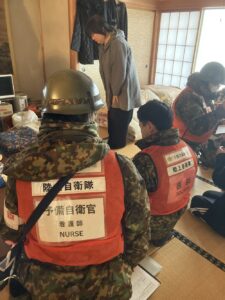Arab News Japan
TOKYO: Japan gets around 1,500 earthquakes a year, most of them small, but it isn’t the little ones that worry seismologists and earthquake observers.
The January 1 earthquake in northern Japan killed over 200 people, but those in the know say this is insignificant to what might happen in the future when a major earthquake hits a densely populated area.
The last time this occurred was in 1995 when over 6,000 people died in the Great Hanshin Earthquake that struck Kobe in central Japan. While the 9.1 magnitude Tohoku earthquake in 2011 resulted in 20,000 deaths, most of those were from the tsunami rather than the quake itself.
Last year, Tokyo remembered the 1923 Tokyo earthquake that resulted in 142,000 deaths. It was a salutary reminder that Japan’s capital and most of its cities are living on borrowed time. For Greater Tokyo’s 35 million residents, that’s a major concern.

As if the possibility of a major quake wasn’t enough, it could also trigger a huge tsunami and even lead to the eruption of Mt. Fuji, still an active volcano, that last erupted 300 years ago after a series of earthquakes in the region.
In MIYAJI Miyoko’s ‘Capital Defense’, the predictions of chaos in Tokyo make for uncomfortable reading.
“According to the Tokyo Metropolitan Government’s estimates, if an earthquake directly hitting the capital were to occur at noon on a weekday in winter, the number of stranded people who would be unable to return home from work or other places outside the city would reach approximately 4.53 million.
Approximately 28,600 people are expected to remain outdoors around Tokyo Station and 37,500 people around Shinjuku Station.”
The book says the economic fallout could be catastrophic. Direct damage would amount to 21.5 trillion yen ($150 billion), but when indirect damage – such as damage to the economy and business – is included that could rise to an astonishing 110 trillion yen ($760 billion).
The Japan Society for Earthquake Prediction is currently most concerned about Japan’s port towns. The Society’s President NAGAO Toshiyoshi says Sado Island, 100 km to the northeast of the Noto Peninsula that suffered the 7.6 earthquake on New Year’s Day, could suffer a major earthquake triggered by the New Year’s Day quake and if the epicenter is in the sea, it could result in a devastating tsunami that hits Niigata City, which has a population of 800,000.
Nagao also expressed concern for Fukuoka City (population 1.6 million) on the southern island of Kyushu. The city has a major unresolved fault right beneath it and he is advising visitors not to stay in old buildings, which are more susceptible to earthquakes.
Earthquake prediction is not easy as major quakes can be precipitated by a “swarm” of small quakes or no activity at all. Nagao says northern Kyushu is a “concern,” as well as Nagano and Yamanashi prefectures in central Japan, and the island of Yakushima in southern Japan.
No one knows where the next huge earthquake will strike, but as one of the most seismically volatile countries in the world, Japan will carry on shaking while its people wait for the next Big One.

